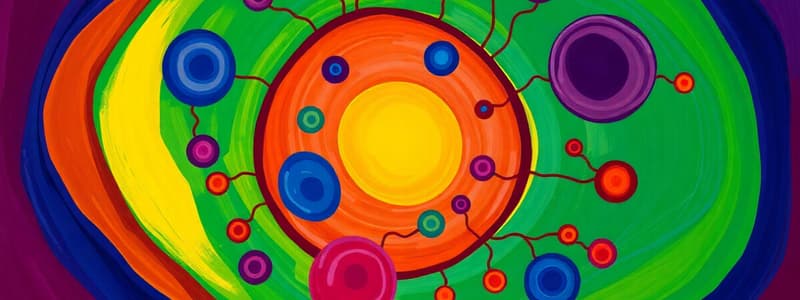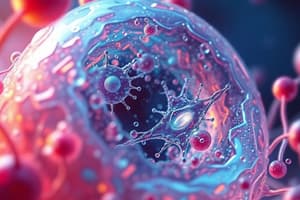Podcast
Questions and Answers
A scientist observes a cell under a microscope and notes the presence of a cell wall, chloroplasts, and a large central vacuole. Which type of cell is the scientist most likely observing?
A scientist observes a cell under a microscope and notes the presence of a cell wall, chloroplasts, and a large central vacuole. Which type of cell is the scientist most likely observing?
- Bacterial cell
- Fungal cell
- Animal cell
- Plant cell (correct)
Why is a high surface area to volume ratio important for cells?
Why is a high surface area to volume ratio important for cells?
- To protect the cell from external damage
- To efficiently exchange materials with the surrounding environment (correct)
- To maximize energy production through cellular respiration
- To minimize waste production within the cell
If a certain poison interfered with the function of ribosomes, which cellular process would be most directly affected?
If a certain poison interfered with the function of ribosomes, which cellular process would be most directly affected?
- Energy production
- Waste disposal
- Protein synthesis (correct)
- DNA replication
Which sequence represents the correct order of levels of organization in a multicellular organism, from simplest to most complex?
Which sequence represents the correct order of levels of organization in a multicellular organism, from simplest to most complex?
During digestion, the process of peristalsis occurs. What accurately describes peristalsis?
During digestion, the process of peristalsis occurs. What accurately describes peristalsis?
In the respiratory system, what is the main function of the alveoli?
In the respiratory system, what is the main function of the alveoli?
Which component of blood is primarily responsible for transporting oxygen?
Which component of blood is primarily responsible for transporting oxygen?
How does regular aerobic exercise typically affect a person's resting heart rate?
How does regular aerobic exercise typically affect a person's resting heart rate?
Which of the following best describes the role of the cell membrane?
Which of the following best describes the role of the cell membrane?
A scientist is using a microscope to study a specimen and needs to see fine details of the internal structures. Which type of microscope would be most suitable?
A scientist is using a microscope to study a specimen and needs to see fine details of the internal structures. Which type of microscope would be most suitable?
Flashcards
Cell Theory
Cell Theory
All living things are composed of cells.
Cell Membrane
Cell Membrane
Controls the entry and exit of substances in a cell.
Nucleus
Nucleus
An organelle containing DNA and controls cell activities.
Mitochondria
Mitochondria
Signup and view all the flashcards
Ribosomes
Ribosomes
Signup and view all the flashcards
Unicellular organism
Unicellular organism
Signup and view all the flashcards
Compound Light Microscope
Compound Light Microscope
Signup and view all the flashcards
Peristalsis
Peristalsis
Signup and view all the flashcards
Alveoli
Alveoli
Signup and view all the flashcards
Veins
Veins
Signup and view all the flashcards
Study Notes
- These Grade 8 science notes cover Cells and Body Systems.
- The unit explores cell theory, cell structure, levels of organization, and various body systems.
Cell Theory and Cell Structure
- Cell theory has three main components: all living things are made of cells, the cell is the basic unit of life, and all cells come from pre-existing cells.
- Cells must maintain a high surface area to volume ratio to efficiently exchange materials with their environment.
Cell Organelles and Their Functions
- Cell Membrane: controls the movement of substances in and out.
- Nucleus: contains DNA and controls cell activities.
- Cytoplasm: is a gel-like substance where processes occur.
- Cytosol: is the fluid portion of the cytoplasm.
- DNA: is genetic material with instructions for cell functions.
- Mitochondria: produces energy through cellular respiration.
- Ribosomes: synthesizes proteins.
- Chloroplasts: (in plant cells only) are the site of photosynthesis.
- Vesicles: are small sacs that transport materials.
Plant vs. Animal Cells
- Plant cells have a cell wall, chloroplasts, and a large central vacuole.
- Animal cells lack a cell wall and chloroplasts, but have centrioles.
Unicellular vs. Multicellular Organisms
- Unicellular organisms consist of a single cell performing all life functions.
- Examples of unicellular organisms: bacteria, amoeba
- Multicellular organisms have specialized cells that work together.
- Examples of multicellular organisms: humans, plants
Microscopes
- Electron microscopes provide high magnification and resolution.
- Compound light microscopes use multiple lenses to magnify small objects.
- Stereo light microscopes provide a 3D view of specimens.
Levels of Organization in the Body
- Cells are the basic unit of life.
- Tissues are groups of similar cells performing a function.
- Organs are structures made of tissues performing specific tasks.
- Body systems are groups of organs working together.
Digestive System
- Digestion is the breakdown of food into absorbable nutrients.
- Peristalsis are wave-like muscle contractions that move food.
- Chyme is a semi-liquid mass of food in the stomach.
- Villi are small finger-like projections in the intestines that absorb nutrients.
- Main organs of the digestive system: mouth, esophagus, stomach, small intestine, large intestine, liver, pancreas.
- Physical digestion involves breaking food into smaller pieces, for example, chewing.
- Chemical digestion involves breaking down food molecules using enzymes, for example, saliva breaking down starch.
Respiratory System
- Trachea: windpipe that directs air to the lungs.
- Bronchi: branches leading to each lung.
- Lungs: organs for gas exchange.
- Pharynx: passageway for air and food.
- Epiglottis: prevents food from entering the airway.
- Alveoli: tiny air sacs for oxygen and carbon dioxide exchange.
- Diaphragm: muscle that helps with breathing.
Circulatory System
- Heart: pumps blood.
- Capillaries: smallest blood vessels where gas exchange occurs.
- Veins: carry blood back to the heart.
Components of Blood
- Red blood cells: carry oxygen.
- Plasma: liquid portion transporting nutrients.
- White blood cells: fight infections.
- Platelets: help in blood clotting.
Heart Rate
- Heart rate measures how many times the heart beats per minute.
- Indicates fitness levels and overall health.
- More fit individuals tend to have lower resting heart rates.
Studying That Suits You
Use AI to generate personalized quizzes and flashcards to suit your learning preferences.




